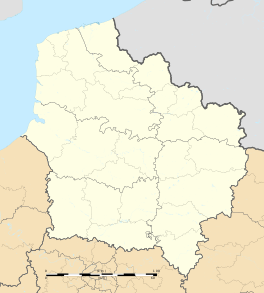Harnes
| Harnes | ||
|---|---|---|
| ||
 Harnes | ||
|
Location within Hauts-de-France region  Harnes | ||
| Coordinates: 50°26′45″N 2°54′24″E / 50.4458°N 2.9067°ECoordinates: 50°26′45″N 2°54′24″E / 50.4458°N 2.9067°E | ||
| Country | France | |
| Region | Hauts-de-France | |
| Department | Pas-de-Calais | |
| Arrondissement | Lens | |
| Canton | Harnes | |
| Intercommunality | Communaupole de Lens-Liévin | |
| Government | ||
| • Mayor (2008–2014) | Philippe Duquesnoy | |
| Area1 | 10.76 km2 (4.15 sq mi) | |
| Population (2010)2 | 12,373 | |
| • Density | 1,100/km2 (3,000/sq mi) | |
| Time zone | CET (UTC+1) | |
| • Summer (DST) | CEST (UTC+2) | |
| INSEE/Postal code | 62413 / 62440 | |
| Elevation |
20–44 m (66–144 ft) (avg. 32 m or 105 ft) | |
|
1 French Land Register data, which excludes lakes, ponds, glaciers > 1 km² (0.386 sq mi or 247 acres) and river estuaries. 2 Population without double counting: residents of multiple communes (e.g., students and military personnel) only counted once. | ||
Harnes is a commune in the Pas-de-Calais department in the Hauts-de-France region of France.
Geography
Harnes is an ex-coalmining and light industrial town situated some 4 miles (6.4 km) northeast of Lens, at the junction of the D162e and the D39. The Lens canal forms much of the southern border of the town and the A21 autoroute passes by a few yards from the canal.
History
First recorded as Hamas, the town was known as Harnis until, in the 12th century, when its present spelling was used. It’s possible that the name comes from the Flemish "Hearn" meaning “Marsh”.
The town was settled during the Gallo-Roman period, as archaeological finds have proved. In the municipal museum of Harnes, one can see the "treasure of Harnes": Coins, building materials, urns, vases, spears, iron objects and bones as well as some Samian ware (red glazed pottery) decorated with eagles, lions, sphinxes etc.
In 1304, Harnes was looted and burned by the Flemish. Under the Counts of Burgundy, from 1384 to 1482, civil and foreign wars were waged. Fighting, famine, plague and epidemics badly affected the people and prosperity of the region.
In 1438, Harnes was recorded with "31 fires (homes) and 109 inhabitants". The village was so poor that it was exempted from paying taxes.
In 1493, during the reign of Philip the Fair, the Austrians attacked France. They made camp at Harnes and then destroyed the castle.
On November 2, 1789, the National Assembly voted through the law of nationalization of all religious property. The people of Harnes were able to buy all the land that once belonged to the monastery, part of the abbey of St. Pierre at Ghent.
Eco water treatment system
In the old riverbed of the Deûle/Souchez river (long-since drained by the creation of the Lens canal) and on the former mining area, the local authorities have created a landscape whose objective is to supplement the wastewater treatment leaving the sewage treatment plant at Fouquières by biological methods to eliminate pathogens and phosphates. Five successive treatments are employed, involving filtration by coppiced willow, tanks planted with reeds, iris, bulrush etc., oxygenation and exposure to sunlight. The energy needed for pumping the water provided by four wind turbines. It takes about one month for the impure water to pass through the cleaning course, before joining the Lens canal. This project, which took five years to build (1999–2004) was awarded the “Rosa Barba” at the fourth biennial European landscape congress in Barcelona. .[1]
Main sights
- The mining museum
- The archaeology and history museum
- Florimond woods
- The “Pont Maudit”, a bridge dating from the 18th century
- The church of St.Martin, dating from the 20th century
- The war memorial
Twin towns
-
 Loanhead, UK
Loanhead, UK -
 Chrzanów, Poland
Chrzanów, Poland -
 Falkenstein, Germany
Falkenstein, Germany -
 Kabouda, Burkina Faso
Kabouda, Burkina Faso -
 Putignano, Italy
Putignano, Italy -
 Vendres, France
Vendres, France
See also
References
External links
| Wikimedia Commons has media related to Harnes. |
- Official website (French)
- Website of the Communaupole de Lens-Liévin (French)
- Harnes on the Quid Web site (French)
